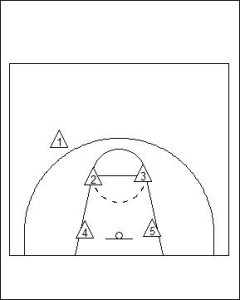What is a Junk Defence?
A Junk Defence brings together elements of both a man-to-man and zone defences. A junk defence looks to play a mix and match style that hopefully breaks the rhythm of an offense. The junk defence can be played out of a number of different formations to challenge the opposition’s offense.
A junk defence can be a very useful tool in limiting the exposure a team has to very strong offensive players. One of the benefits of a junk defence is that it provides good support to those players who are matching-up on individual players using man-to-man defensive principles. The players who are in the zone element of the junk defence are always placed around the keyway in good help defence positions. For example in a Triangle and Two junk defence there are three defenders within the zone element of the defence. These three players as depicted in the diagram below (Three, Four and Five) are traditionally in a triangle formation. This in turn sees a player covering the top of the keyway and a player on either side in a strong help position.

The players within the junk defence using man-to-man principles can play defence using a number of different strategies. In some cases, the offensive player being guarded might be so effective that a defensive player might be excused from playing any help defence in lieu of denying their defensive assignment any contact with the ball. In other situations, the defensive player might be asked to apply standard man-to-man principles, so the defender will, if their player is on the weak side of the floor, take-up a help defence position.
Another advantage of a junk defence is that it usually provides strong rebounding positioning. In the Triangle and Two or the Box and One (see diagram below) the players within the zone element are all placed around the keyway. These players have a strong initial position for securing inside rebounding coverage. However, remember that this does not always equate to rebounding success, for that to be the end result the defensive players still need to apply good rebounding technique principles to indeed turn this from a potential advantage into a statistical reality.

Within the junk defence there is also the potential to trap more effectively. This is due to the player movement of the defenders in the zone element not needing be on the significant as much as in man-to-man defences. As a result, the defenders can be much more calculating in when to ‘spring’ a trapping situation on an offensive player. The trapping scenario can be played out through all different types of junk defences, but will be more effective in those formations with less players playing in the man-to-man principles.
When looking to implement a junk defence into your defensive playbook you should note that these types of defences are not regularly used for long periods of time during general game play. Most junk defences are used as a change up to break the rhythm of the opposition’s offense. This does not however mean they cannot be used frequently during a game, just preferably not for long periods of time. Switching between difference defensive tactics will help with the prolonged use of a junk defence and continue to confuse the opposition’s offense.







Send me more more defense drills for youth guys thank you.